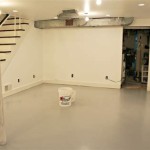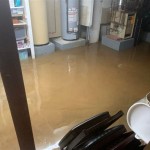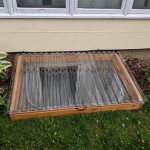Alternative Solutions to French Drains in Basement Waterproofing
Basement water intrusion is a persistent problem for many homeowners. Traditional French drains, while effective in many situations, are not always the most practical or cost-effective solution for every basement waterproofing scenario. Several alternative methods exist, offering varying degrees of effectiveness depending on the source and severity of the water problem. This article explores some of these alternative basement waterproofing techniques, detailing their mechanisms, advantages, and disadvantages. Properly diagnosing the cause of basement dampness is crucial before choosing any particular method.
French drains function by collecting groundwater that accumulates outside the foundation wall and diverting it away from the building. They typically involve excavating a trench around the perimeter of the foundation, installing a perforated pipe surrounded by gravel, and covering the entire assembly with a filter fabric to prevent soil intrusion. The water flows through the gravel and into the pipe, which then directs it to a discharge point like a sump pump or a natural drainage area. While effective, installing a French drain requires significant excavation which can disrupt landscaping and potentially undermine structural integrity if not done correctly. Therefore, it's important to consider other methods before committing to this extensive undertaking.
Exterior Waterproofing Membranes
One common alternative to a French drain is the application of an exterior waterproofing membrane. This involves excavating around the foundation to expose the exterior walls, cleaning the surface, and applying a waterproof sealant. This sealant can be a variety of materials, including asphalt-modified polyurethane, polymer-modified asphalt, or bentonite clay. The goal is to create a barrier that prevents water from penetrating the foundation walls in the first place. Some membranes can even bridge existing cracks within foundation walls. This can be an adequate alternative if the amount of water coming through the foundation is minimal.
The effectiveness of an exterior waterproofing membrane largely depends on the quality of the application and the type of material used. Careful surface preparation is critical. The foundation wall must be clean, dry, and free of loose debris for the membrane to properly adhere. The membrane must be applied uniformly and without any gaps or weak points. Proper backfilling is also essential; using gravel or sand close to the foundation wall can help facilitate drainage and protect the membrane from puncture during backfilling activities.
An additional layer of protection, often used in conjunction with a waterproofing membrane, is the installation of drainage boards. These corrugated plastic panels are placed against the foundation wall to provide a channel for water to flow down to a footing drain system. This helps relieve hydrostatic pressure, preventing water from accumulating against the wall and potentially finding its way through cracks or imperfections in the waterproofing membrane.
This type of waterproofing is best done during construction or a major landscaping overhaul, as it requires excavation around the basement. If the main issue is surface water runoff, then this method might need to be combined with measures to direct water away from the foundation.
Interior Waterproofing Systems
For basements where exterior excavation is impractical or undesirable, interior waterproofing systems offer an alternative approach. These systems typically involve managing water that has already entered the basement rather than preventing its entry from the outside. A common component of an interior system is the installation of an interior drainage system, which intercepts water seeping through the walls and floor and directs it to a sump pump. This system usually involves creating a channel around the perimeter of the basement floor, installing a perforated pipe within the channel, and covering it with a layer of gravel or concrete. The collected water is then pumped out of the basement through the sump pump.
Interior waterproofing systems address the symptom of water intrusion rather than the root cause. The walls remain damp and the hydrostatic pressure outside the foundation is not being relieved. Thus, these systems are often paired with a vapor barrier installed on the interior walls to prevent moisture from entering the living space. The vapor barrier is typically a plastic sheet or a specialized coating that creates a waterproof layer on the wall surface. This redirects the water down to the interior drainage channel. This is often a less expensive and disruptive approach than exterior methods, particularly if the water table is high or excavation is difficult.
Another consideration with interior systems is the sump pump. A reliable sump pump is critical for the system to function effectively. The pump must be adequately sized to handle the volume of water being collected, and it should have a backup power source in case of a power outage. Regular maintenance is also essential to ensure the pump is functioning properly and free of debris. A backup sump pump is often recommended for added security, especially in areas prone to heavy rainfall or flooding.
While interior systems do not stop water from entering the foundation, they can effectively manage the water and prevent it from causing damage to the basement’s interior. However, it is important to be aware that these systems do not address the underlying cause of the water intrusion, which could potentially lead to structural problems over time.
Surface Water Management
Often, basement water issues are not due to high water tables or underground sources, but rather to surface water runoff that is not properly directed away from the foundation. In these cases, surface water management techniques can be an effective and less intrusive alternative to a French drain. These techniques focus on preventing water from pooling around the foundation and saturating the soil. Implementing effective surface drainage can significantly reduce the amount of water that reaches the foundation, thus mitigating the risk of basement water intrusion. This also reduces hydrostatic pressure on the outer walls.
One of the most common and effective surface water management techniques is ensuring proper grading around the foundation. The ground should slope away from the building at a rate of at least six inches over the first ten feet. This helps to ensure that rainwater and snowmelt flow away from the foundation rather than towards it. Soil erosion and settling can alter the grading over time, so it is important to periodically check and re-grade as needed.
Another important aspect of surface water management is the proper maintenance of gutters and downspouts. Gutters should be kept clean and free of debris to ensure they can effectively collect rainwater from the roof. Downspouts should be extended away from the foundation, directing water at least four to six feet away from the building. Downspout extensions can be made of plastic, metal, or even flexible tubing. In some cases, underground drainage systems can be used to carry water even further away from the foundation.
In areas with heavy rainfall or poor soil drainage, installing a swale or a dry well can also be beneficial. A swale is a shallow, vegetated ditch that is designed to collect and convey surface water. A dry well is an underground structure that allows water to slowly infiltrate into the soil. Both of these options can help to reduce the amount of water that reaches the foundation and decrease potential basement water issues.
Landscaping modifications can also play a significant role in managing surface water. Planting trees and shrubs can help to absorb excess water from the soil. Mulching around plants can also help to reduce soil erosion and improve water infiltration. Selecting plant species that are adapted to wet conditions can further enhance the effectiveness of landscaping as a water management tool.
By focusing on surface water management, homeowners can often address basement water issues without the need for more invasive and expensive solutions like French drains. Proper grading, well-maintained gutters and downspouts, and strategic landscaping can all contribute to a drier and more comfortable basement environment.
Ultimately, choosing the right solution for basement waterproofing depends on a thorough assessment of the specific problem. Factors such as the source and severity of the water intrusion, the soil conditions, the landscaping, and the homeowner's budget all play a role in determining the most appropriate and effective method. Consulting with a qualified basement waterproofing contractor is recommended to ensure an accurate diagnosis and a reliable solution.

French Drain Vs Waterguard Interior Drainage System

Footing Drain Interior French Pros And Cons Sani Tred

7 French Drain Alternatives To Water Away Effectively Worst Room

French Drain Vs Waterguard Interior Drainage System

Basement Waterproofing Water Infiltration Or Drainage Problems In Gatineau Qc Alternative Of The Usual French Drain

7 Best French Drain Alternatives To Consider With Images

3 Reasons French Drains Are Not A Good Basement Waterproofing Option Acculevel

7 Best French Drain Alternatives To Consider With Images

Interior Vs Exterior Drainage Systems Basement Inc Press Release

Basement Waterproofing Interior Drain In Montreal Alternative To The French







